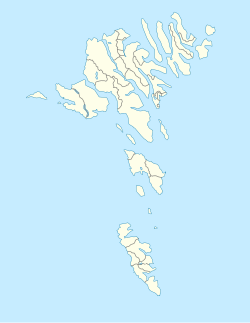
The Faroe Islands is served by an internal transport system based on roads, ferries, and helicopters. As of the 1970s, the majority of the population centres of the Faroe Islands have been joined to a single road network, connected by bridges and tunnels.
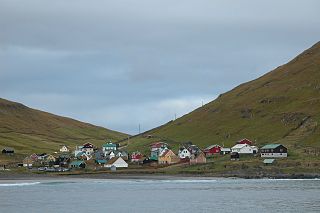
Húsavík is an old village located on the east of the island of Sandoy, in Húsavík Municipality, Faroe Islands.

Skúgvoy is an island in the central Faroe Islands, located to the south of Sandoy.
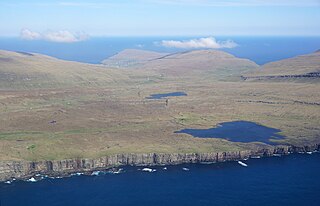
Sandoy is the first of the five southern islands that make up the Faroe chain, the fifth biggest of all the Faroe Islands, an autonomous region of the Kingdom of Denmark. It also refers to the region that includes this island along with Skúvoy and Stóra Dímun. As of January 2020, the largest population centre on the island is the village of Sandur with a population of 532. Other settlements include Skarvanes, Skopun, Skálavík, Húsavík and Dalur.
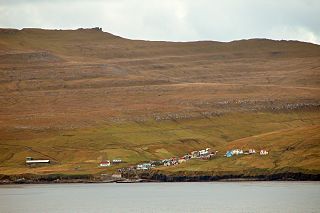
The village Skúvoy lies on the east side of the island with the same name.

Sandvík is the northernmost village of the island of Suðuroy in the Faroe Islands. It is situated on the northern side of a shallow fjord. The village was previously known as Hvalvík. It changed its name to Sandvík in 1913 as there was too much confusion regarding mail delivery, because there is another village named Hvalvík on Streymoy. The village had originally been known as Sandvík during the Viking Age.
The Sandur hoard of the Faroe Islands was found in Sandur in 1863 and consists of 98 medieval silver coins, which were probably buried between 1070 and 1080. The hoard is the oldest and only coin hoard found on the archipelago.

Skopun is a town in the Faroe Islands situated on the northern coast of Sandoy.

Faroese art is art by artists living in the Faroe Islands and art by Faroese nationals living abroad. In the Faroe Islands, art is an important part of everyday life and in the public debate. It may be the special light in the Faroes which causes so many to express themselves in painting. The ever-changing Faroese weather and light provide opportunities for endless nuances, something which has fascinated both foreign and local artists over the years. However, the history of Faroese art is short, and can only be dated a couple of hundred years back. Lack of time, light and materiel may have caused the late appearance of painting. But despite this, the islands have a very active art scene. A great many of the Faroese artists of today resent being reminded that Faroese art is a comparatively recent phenomenon. They find such an observation annoying as regards their artistic work, and they claim that such a statement has no bearing whatsoever on them as artists as their frame of reference is both local and global.

Strandfaraskip Landsins is the government agency for public transport in the Faroe Islands. It is owned by the Faroese national government under the Ministry of Finance (Fíggjamálaráðið) and runs seven ferry routes and a number of bus routes.
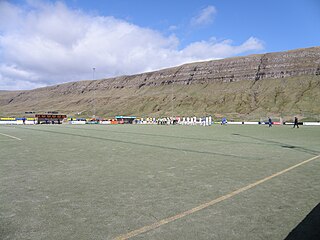
Inni í Dal, roughly translated to "In the Valley", is a location on the island of Sandoy, The Faroe Islands. Inni í Dal is the home ground of local football team B71, but also the location the joint public secondary school of Sandoy, Sandoyar Meginskúli.

Skálavík is a village and municipality on the eastern coast of the Faroese island Sandoy.

Brandur Sandoy is a Faroese politician, sheep farmer and businessman. His surname is the same as the name of the island Sandoy, where he lives. He runs a sheep farm in Inni í Dal between Sandur and Skopun, near the school and football stadium of B71 Sandoy. He also runs a small business named BS-Smíð and rents a holiday home together with his wife Anja Sandoy, with whom he has three children: Várdis, Pauli and Pál. He is a former football player, he played for B71 Sandoy in the 1990s.

Sandoyartunnilin is an undersea road tunnel in the Faroe Islands. It connects the main island of Streymoy with Sandoy to the south. The length of the tunnel is 10.8 kilometres (6.7 mi) and the estimated cost is 860 million DKK. The tunnel opened for traffic on 21 December 2023, after which the ferry Teistin ceased its route between Gamlarætt on Streymoy and Skopun on Sandoy. The tunnel crosses the Skopunarfjørður and runs from Gamlarætt to Traðardalur in central Sandoy, near the Inni í Dal stadium.

Demmus Hentze was a Faroese politician and lawyer. He served as the Finance Minister of the Faroe Islands from 1975 to 1981.
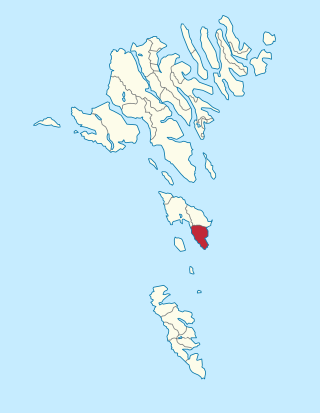
Húsavík Municipality is a municipality of the Faroe Islands. The town of Húsavík is the administrative centre.
The Suðuroyartunnilin is a proposed submerged fixed-link in the Faroe Islands, linking the island of Suðuroy to Sandoy. As of 2023, all vehicles and cargo, and virtually all passenger traffic must use the ferry service.
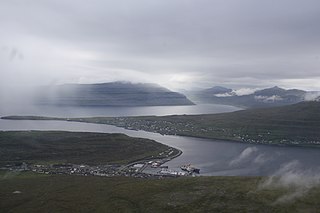
The Faroe Islands consist of 18 islands, several of which are deeply incised by fjords.

Gamlarætt is a ferry port in the Faroe Islands. It is situated on the southwestern side of the island of Streymoy, the largest island in the Faroes, between the villages of Velbastaður and Kirkjubøur. It accommodates ferry services to the islands of Sandoy and Hestur. The port is also used for local salmon farms.


